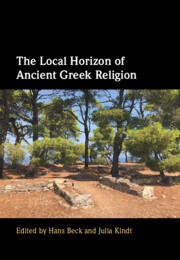Book contents
- The Local Horizon of Ancient Greek Religion
- The Local Horizon of Ancient Greek Religion
- Copyright page
- Contents
- Figures
- Contributors
- Preface
- Abbreviations
- 1 Localism and the Study of Ancient Greek Religion: The Example of the Divine Persona
- 2 Refitting the Local Horizon of Ancient Greek Religion (Including Some Remarks on the Sanctuary of Poseidon on Kalaureia)
- 3 Mycenaean Greek Worship in Minoan Territory
- 4 Hera on Samos: Between the Global and the Local
- 5 Polytheism and the Distribution of Votives in the Corinthia
- 6 Demeter Chthonia at Hermione: Landscapes and Cult
- 7 Local Variation in the Thesmophoria Festival: A Case Study of the Attic and Sicilian Thesmophoria Festivals
- 8 The Lindian Chronicle and Local Identity
- 9 Shifting Identities and Defensive Localism: Conflicts of Religious Narratives in Post-Synoikism Rhodes
- 10 Between Local and Global? Religion in Late-Hellenistic Delos
- 11 Personal or Communal? Social Horizons of Local Greek Religion
- 12 How to Write a Local History of Imperial Greek Cults: Observations from Pausanias
- 13 Panhellenic Sanctuaries: Local and Regional Perspectives
- Epilogue: A Tribute to Potnia of the Labyrinth
- Index
- References
13 - Panhellenic Sanctuaries: Local and Regional Perspectives
Published online by Cambridge University Press: 06 April 2023
- The Local Horizon of Ancient Greek Religion
- The Local Horizon of Ancient Greek Religion
- Copyright page
- Contents
- Figures
- Contributors
- Preface
- Abbreviations
- 1 Localism and the Study of Ancient Greek Religion: The Example of the Divine Persona
- 2 Refitting the Local Horizon of Ancient Greek Religion (Including Some Remarks on the Sanctuary of Poseidon on Kalaureia)
- 3 Mycenaean Greek Worship in Minoan Territory
- 4 Hera on Samos: Between the Global and the Local
- 5 Polytheism and the Distribution of Votives in the Corinthia
- 6 Demeter Chthonia at Hermione: Landscapes and Cult
- 7 Local Variation in the Thesmophoria Festival: A Case Study of the Attic and Sicilian Thesmophoria Festivals
- 8 The Lindian Chronicle and Local Identity
- 9 Shifting Identities and Defensive Localism: Conflicts of Religious Narratives in Post-Synoikism Rhodes
- 10 Between Local and Global? Religion in Late-Hellenistic Delos
- 11 Personal or Communal? Social Horizons of Local Greek Religion
- 12 How to Write a Local History of Imperial Greek Cults: Observations from Pausanias
- 13 Panhellenic Sanctuaries: Local and Regional Perspectives
- Epilogue: A Tribute to Potnia of the Labyrinth
- Index
- References
Summary
This chapter targets the local horizon of sanctuaries whose scope and spheres of influence transcended the local. Variously labelled as ‘regional’ or ‘Panhellenic’ sanctuaries, Funke’s contribution challenges the implicit dichotomy between these descriptors and the local. He begins with the observation that religious conduct in the polis was always subject to diverse spatial dynamics, articulated, for instance, in the different reach of urban and liminal cult sites. A similar spatial and functional diversification is pitched for Panhellenic sites. Rather than being elusive or purely notional, Panhellenic perspectives manifested themselves in the evocation of Greek gods and in cult practices that were considered genuinely Hellenic in nature. As shared points of reference, Panhellenic commodities were not only commonly accepted by the Greeks but, in fact, were substantiated through hardwired regulations that assured availability to all.
- Type
- Chapter
- Information
- The Local Horizon of Ancient Greek Religion , pp. 362 - 375Publisher: Cambridge University PressPrint publication year: 2023



